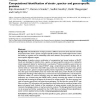Free Online Productivity Tools
i2Speak
i2Symbol
i2OCR
iTex2Img
iWeb2Print
iWeb2Shot
i2Type
iPdf2Split
iPdf2Merge
i2Bopomofo
i2Arabic
i2Style
i2Image
i2PDF
iLatex2Rtf
Sci2ools
BMCBI
2005
2005
Computational identification of strain-, species- and genus-specific proteins
Background: The identification of unique proteins at different taxonomic levels has both scientific and practical value. Strain-, species- and genus-specific proteins can provide insight into the criteria that define an organism and its relationship with close relatives. Such proteins can also serve as taxon-specific diagnostic targets. Description: A pipeline using a combination of computational and manual analyses of BLAST results was developed to identify strain-, species-, and genus-specific proteins and to catalog the closest sequenced relative for each protein in a proteome. Proteins encoded by a given strain are preliminarily considered to be unique if BLAST, using a comprehensive protein database, fails to retrieve (with an e-value better than 0.001) any protein not encoded by the query strain, species or genus (for strain-, species- and genus-specific proteins respectively), or if BLAST, using the best hit as the query (reverse BLAST), does not retrieve the initial query prot...
| Added | 15 Dec 2010 |
| Updated | 15 Dec 2010 |
| Type | Journal |
| Year | 2005 |
| Where | BMCBI |
| Authors | Raja Mazumder, Darren A. Natale, Sudhir Murthy, Rathi Thiagarajan, Cathy H. Wu |
Comments (0)

